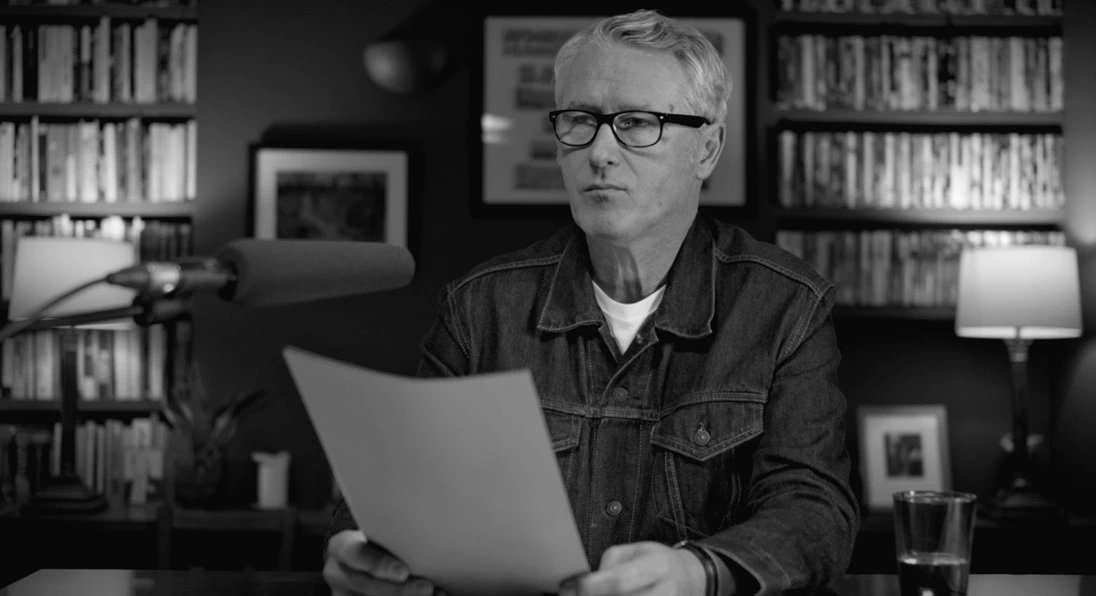
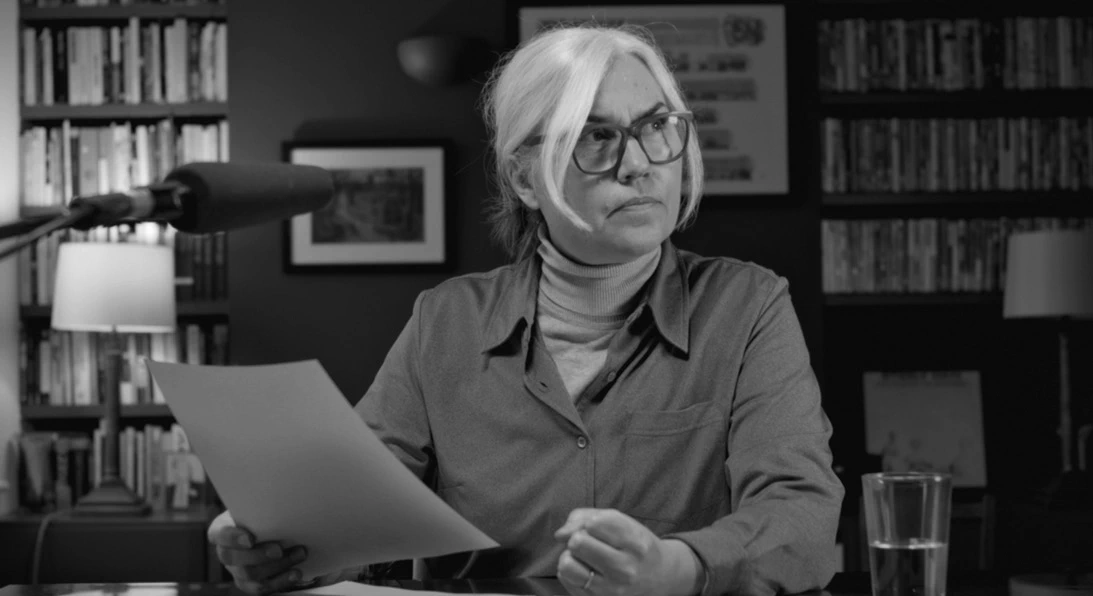
The Future Tense – photographs by Joe Lawlor.
In different places different thoughts emerge …
Rebecca Solnit, A Book of Migrations: Some Passages in Ireland
Born in Dublin, life and creative partners since 1983, artists Christine Molloy and Joe Lawlor have worked across media – and between Ireland and England – for some four decades now, crafting a body of work that is both singular and multi-faceted in intention and expression. Often drawing on their own family biographies, at its heart is a remarkably layered investigation into forms of identity – personal, social, cultural, national – and the multiple possibilities of lives informed by place. From bold, early years in community drama, through transformative study at Dartington College of Arts in Devon in the late 1980s, to a decade of striking experimental theatre (where they worked as Desperate Optimists) and early artistic adoption of online platforms, they emerged in the early 2000s as ambitious film-makers.
Their multi-part short film series Civic Life, crafted with residents and community groups across the UK and Ireland, was at once performative and highly cinematic, shot in complex single takes on 35mm. Since 2008 they have made three acclaimed feature films (Helen, Mister John and Rose Plays Julie) and two innovative documentary essay films (Further Beyond; The Future Tense, forthcoming). Natural collaborators who retain a strong authorial control over all aspects of production, they are currently developing two historically-sourced features – Baltimore, based on the life of debutante-militant Rose Dugdale; and Claude Cahun & Marcel Moore, about artists Lucy Schwob and Suzanne Malherbe. This career-spanning conversation took place via a significantly extended Zoom call in June 2022.
Gareth Evans: Having just watched The Future Tense, what is so striking about it, and indeed all the work, as you have said elsewhere, is what we might call its primary investigation: identity under duress. Where does this lifelong fascination with identity come from?
Joe Lawlor: Well, as we’ve mentioned in the film, there is that conjecturing of leaving Ireland to go to the UK and finding out what kind of transformations can happen there, known or unknown. You can kind of tell something changed, but it’s hard to put your finger on it. And for me in particular, growing up, watching my mother Helen, and the kind of transformations that she would go through, makes you think about who we are, what we’re made of, how stable we are. I also recall being in primary school, at the older end of it, looking out of a window at the Dublin mountains, and the teacher telling us to concentrate because, if we don’t, we might grow up to be a bin man. If you’re lucky, you’ll be a bin man, because unemployment was so high and you kind of think, what’s in store for us all? Because there’s absolutely nothing clear about where we’re going.
My dad trained as a fitter and turner. But in the 1970s he gave up on it and ran the stores in the sweet factory. He took a huge pay cut and you can kind of see him giving up the ghost to some degree. And by the time it comes to 1989, he’s dead, at only fifty-eight. So I suppose looking at the world around you, you have to really weigh up what life you want to lead, because I’m looking at the various role models, so-called, and it’s not looking great, and you have to really think hard and nobody is leading the way. It’s not like you’re born into a middle class family where there are expectations and hopes and dreams and desires. You know, no one is rooting for you. Expectations are low, incredibly low. There’s lots of love, but there isn’t any vision or plan or hope, other than, maybe, you get a job.
Christine Molloy: They’re also trying to create a situation where you stay and don’t go because that’s the threat. We’re growing up in the ’80s and Ireland was all about the threat of going, of not staying.
JL: My family had already succumbed to that. The two older ones had already gone. So for me as a teenager, when I’m meant to be studying, I can’t see the point. Apparently I changed when I was twelve and my brother went blind. A teacher said to my mother, he’s not the same; his concentration at school is gone completely. And I turned to daydreaming and reading fiction. I’m reading these books, and dreaming of worlds. So you’re kind of like a mushroom in the dark. You’re trying to grow with very little, and you’re kind of attaching yourself to anything at all that will help you grow or nourish you. It’s amazing how much you can grow in the dark, actually. The same as with Christine, there are no precedents for that in the family histories at all.
How then did your creative lives as teenagers come about in Dublin?
CM: Some things happen by accident and are not really in your control and one of the things in Ireland at the time as well was that there was massive unemployment, big emigration, and also there was a lot of young people. Ireland had the highest number of young people in any country in Europe under the age of twenty-five. By the time we left school we were part of this very vibrant, energetic scene where Dublin was full of young people, just doing what you want to do as there isn’t a future for you, and so there’s no point in being motivated towards the future because there’s nothing on offer.
Joe ended up going for a couple of interviews that were about trying to get young people into some kind of formal training to prepare them for the job that didn’t exist, but it was a way of getting people off the dole and it was run by this government body, AnCo. And Joe had two interviews on the same day.
JL: Oh, this is a classic ‘what if’ moment. I walk into this government office in Pearse Street and on the left hand side of the window is a range of training prospects, as there is on the right hand side. One of them says travel agent and the other says community cultural worker. I’ve no idea what the latter is. I have a sense of what the former is and I do an interview for both. I didn’t get the travel agent. And for the other one, Peter Sheridan (a key Dublin theatre mentor) was on the panel. Anyway, I was one of twelve lucky people to be offered this place, and one of the younger people actually. People were all ages: twenties to fifties, ex-trade unionists, an ex-nun and so forth. So I’m on this amazing course, run by Peter, bringing incredible people in. Plus we did a week or so on the road where we got to go to various places around the country.
CM: In parallel to that, I actually had a job as a clerical assistant. It was like the lowest of the low. I worked in a postal sorting room with all the kind of people who, you know, had had nervous breakdowns or psychotic episodes. But it gave me loads of time to sit around doing my own thing. And Peter was also involved in this organization called CAFÉ – Create Activity for Everyone – and it was all about the democratisation of the arts. That was all heady stuff for us. So we just kind of stumbled into this world by total accident at the right moment. We didn’t have the credentials. We didn’t have an identity, but we found ourselves in these rooms.
JL: But you gather an identity quickly. You do. And before you know it, you’re having raging debates about process over product and you’re willing to more or less die for this cause. I did the training for six months and then a placement with the Dublin Youth Theatre, which is where I met Aidan Gillen, actually.
CM: There was also the National Youth Theatre. And we were on a board at the time, the NYDA, the National Youth Drama Association, and we proposed that in parallel to the NYT, which is all product by the way, wouldn’t it be interesting if there was a weekend held in Dublin in Saint Francis Xavier Hall. If it was a weekend where young people coming from new theatres and youth drama clubs from around the country all converged and shared and swapped and hung out with each other and did workshops and had lunch together.
Because you had the NYT, and it was very elitist, with traditional auditions, and then all this tremendous energy and talent gets rejected. And because we were so young and full of ourselves, they actually found the money to hold the first national youth drama festival in Ireland. It was held over a weekend, and to this day that festival in a different form is still running. I remember hand-drawing the first poster and pamphlets in my civil service job!
JL: We ourselves didn’t run it. We got in more experienced people to do workshops, really good people, and there were something like two hundred people taking part in the end. It was quite something.
CM: Then Joe ended up getting a job, with no qualifications, in a vocational education college in Dublin as a teacher. He’d never been to university and had even failed at school in most exams, more or less. He’s probably one of the very few paid drama teachers in the whole of the country at the time, but there was a limit to what we could know because we’d never trained and there was a sense that this can only go so far. It was Peter who suggested we needed to really immerse ourselves in a world where we were the students. As the teacher, there was a limit to how much you can do because you haven’t invested the time in your own education.
JL: It very rapidly became apparent to us that actually product really did matter because, if you have a group of young people essentially trying to make something, it’s really important that they don’t bore each other, that they excite each other, and that it’s the product that you’re going to present to each other. Let’s not have this false either/or.
You’ve both given very vivid reports on the process by which you became ‘somebody else’ and found your way towards the ‘creative life’. But I’m still curious as to why that question of identity became so central, not just in terms of being able to make work, but then becoming the subject of the work?
CM: Well, I don’t really think that that was clear when we first went to Dartington. The turning point for us, I think, was in our final year there, when we had to do a thing called a ‘statement in action’, which was asking us to reflect on who we were and how we wanted to present ourselves to the world going forward, which is when we made this show called Anatomy of Two Exiles, which is the very first time we saw ourselves as two Irish people who had left Ireland and come to the UK and possibly imagined going back to Ireland, because that had always been the plan. We threw a spotlight on ourselves and in a way it brought something to the fore that never went away.
JL: Just to add to that, whatever the performance was that you were going to present, it was important to try and define what your relationship to theatre was. So there was always a questioning of form; how something is formed; and what’s the difference between this form and that form. You could say that going to Dartington was the beginning of a kind of radicalization in art and culture for us.
CM: From that point on, you think, well, what if we’d stayed in Ireland? Or what if we had gone to film school rather than to Dartington? How different would our journey have been? Because you can’t unthink the things we began to think and our approach to work, as Joe has said, has always been a formal exploration, first and foremost. Of course we’re interested in stories and ideas and the content, but the formal exploration is the thing that really interests us the most and excites us the most, and that absolutely and directly comes out of Dartington, no doubt about it.
So now you’ve finished studying, you’ve made Anatomy of Two Exiles, and for the rest of the 1990s there’s basically a new touring show once a year – Hope, Dedicated, Indulgence, Stalking Realness, and Playboy. How did this extremely productive period begin and maintain itself as a viable project, creatively and practically?
JL: The critical thing was that we had been doing a lot of producing in Ireland. So you’re producing this event. What mechanics do you need to put into place? We found we were pretty good at organizing. In Scotland at the CCA there was the National Review of Live Art, which was a large platform, but it hadn’t been on for a year or two, for some reason. So we said, fuck this; we don’t have any platform to showcase our work, so we’re going to do it ourselves. And we muscled the college to stump up the money. We set up a steering committee, we did the marketing and we went to all the key players around the country. We paid for their trains, their accommodation; we’d look after them, feed them. And anybody who was anybody running a venue in the country came down.
And it just so happened that at our spring platform, we had the world premiere of Anatomy of Two Exiles, so we had everybody in the room that needed to be in the room. And then we got a commission for the next piece, and then a national tour came. You need to craft the context into which you’re going to put that product.
CM: In England then there was dedicated touring theatre funding. So you put your tour together. You get the funding and spend the year making the work and you turn around and come back the next year. Back in the day, there was also the possibility that you could get three-year core funding. So actually you could earn a living of some description … But we never got it. So you’re never really being paid properly. You’re having to do everything yourself. So you couldn’t build. You’re always just trying to survive.
JL: And you have to work full-time as well, of course.
CM: It made me feel somehow that we’ve ended up in a place that’s never really changed, where we’re always outsiders. We’re not quite in here, although this is the country we live in, and we’ve been here since 1987. And we’re certainly not in back in Ireland, as we left, and although we go back and have always gone back over the years, for the theatre work we’re not in, so we’re kind of neither here nor there, and we’ve never quite fit.
So with the theatre work, two things happened. It became really difficult and impossible to continue to live that way, with a sense that for us it’s never going to change. And secondly, it was our interest in film. It had always been there. We realized that actually our real commitment and passion, if we were honest, was not to the live work but to film … So how the hell do we get from here to there?
So you’ve come to the end of the performance cycle. Now you’re moving into taking a lot of those skills from the earlier community organizing and from the production aspect of things, and what you’ve learned about the relationship between process and product, and you’re creating your own context with civic organizations, councils and others to make the short films that became the series Civic Life. How did that come about?
CM: The quick answer: in that transition of trying to find our way with film we did quite a number of projects like video installations, community-based video work and then online episodic stuff on the internet. This was in the early days of flash animation and before QuickTime was ever a feature online. We were trying to feel our way as the technology was changing. And we were also trying to understand non-linear editing. The equipment was still very expensive, but we could begin to have access to it in different ways to understand how video and digital technology is impacting. But film as it traditionally was, with stuff being shot and projected on film, this was still a really big thing for us.
We couldn’t access that yet, but we could access this. At the same time, as luck would have it, we did a piece of work called London Framed, which was a big community art project, this long weekend with different communities in different parts of London. And it ended up as a piece of work online. This woman in Enfield council had a pot of money to help have a cultural celebration of the launch of the loop of the New River that went through the borough. Her big thing was film and she saw London Framed and offered us the commission to make something meaningful that would have a life after the weekend of celebrations. And Joe, it was your idea to use the money to make a film on film rather than on video …
JL: We said, well, let’s find out how much it would be because our pitch was to make a piece of film on 35mm and project in the local multiplex so that all the people who are in it – 150 or 170 people – could then watch themselves in their local neighbourhood on the big screen with the same production values as any feature film that was playing. That was the pitch and we had twenty grand to do it.
So we can afford to buy three rolls of film, a thousand feet a roll, but we can’t afford to process two of them … We can only afford to process one of them, and the other two go in the bin. And you shoot at forty-eight frames a second, so it comes out as a ten-minute shot. But we shoot it in one shot because we can’t afford to get it edited. Brilliant, that’s much cheaper, and we’ll just do it in the one day, because we’re doing it in one shot, so it has to be one day, so that’s cheaper again.
CM: Let me say as well, it brought together three things for us: the community-based nature of the endeavour, the merging of process and product, and theatricality. So there’s a liveness – although it’s being shot on film and it’s cinema, it also has that. It’s a thing that’s been made in the moment and we wanted that energy in the film. In the early days of cinema they filmed people coming out of the factory, and then sold them tickets so that they could come and see themselves on screen later that day. So it was like, we’re all going to work together, to try and make something special, and then we’re going to come back and present it, and it’s going to be beautiful.
JL: It was an old idea. But it’s an idea you would never get if you went to film school. It’s antithetical to that kind of process. However, it’s exactly the kind of thing you would do if you went to Dartington, or if you’ve come through a political / community theatre background where you were open to mistake / error / flow / process. So we did a very interesting one called Daydream that I still think was under-appreciated. As a piece of film-making, I think it was really, really strong, and maybe just a little bit misunderstood, but it was at that moment that we made Daydream that we were thinking, okay, now we’ve made this piece and it’s become a little bit more written and now we’re beginning to outgrow this form and this process. You need to move. You need to change. And also, the craft will tell you what the next step is, because something about it worked very well or something didn’t quite work, but it’s an indicator. What we learned is the next step has to be a feature film.
CM: When we were in Dartington, we were doing a theatre degree and the whole ‘live art’ thing was up and running, and I remember at the time we were really up in arms and angry and we said, we’re going to call our work theatre. If you don’t call it theatre, then you’re not challenging theatre, you’re letting it off the hook. So this really nice guy, a documentary film-maker saw Daydream in the gallery, and he felt that the work almost belonged in the gallery. But the discussion about the work that we made, including the film Helen – is it really cinema or are they gallery pieces? This stubbornly persisted over the years, so much so that the Irish Times has always said our work belongs in the gallery, that we don’t make cinema. When you do try and push you can find yourself and the work being misunderstood and not being taken on its own terms.
JL: But ordinary people from the street who are going in to see the work invariably would be much more open-minded and less bothered about what something is. They’re trying to connect with it on another, deeper emotional level, and it has always been very important to us that it connects, but it’s become incrementally more and more important.
CM: Sometimes I would find myself defending or trying to protect Helen and I’d say, well, you know it is a community arts project, because that’s exactly what it was. And once it was in the cinema world, it felt very exposing because it’s so particular.
JL: However, Helen did get phenomenally well reviewed – it was the film of the week and it went to an incredible quantity of festivals. Every weekend we were off to Hong Kong, Mexico, South Africa, Poland … And Chris Collins [rest in peace – a great supporter of innovative UK film-makers] from the BFI called us in, and Lizzie Francke [the former head of the BFI Film Fund] – they both really loved Helen. And they wanted to work with us on our next feature, which we did. And so we embarked on the writing process. Formally, that’s been the big game-changer.
CM: Yeah, so now we’re trying to make our second feature film, and we don’t know what a synopsis is. We don’t know what a treatment is or how to write one, and we actually really don’t know how to write a script. So although we’ve made a feature film, we don’t know any of these things because we’ve never been to film school. It was pretty torturous, and then we ended up filming it in Singapore, so it’s like again we’re not making an easy path for ourselves. There are easier ways through everything, but we somehow laid this path in a very complicated and difficult way, and it was partly a nightmare, very, very difficult, very stressful and really learning the hard way. But I think one of the things we cottoned on to was: we make work so, if we’re going to write and direct then of course we’re going to edit. It’s our film and we’ve got to stay with it until the end. But we’re trying to work in an industry that doesn’t necessarily like you working in that way.
JL: I have to say, when we approached Screen Ireland, previously known as the Irish Film Board, there was no problem. Simon Perry was involved. Lots of support, he really loves it. Helen went to Telluride [an important, independent US film festival]. They give us completion funding to put it on a print, a proper print. They saw that Helen got out there. It was an Irish cultural product. And so they were all supporting that.
CM: When we made live work, as we said earlier on, it’s cyclical; so you make a show every year. When we made our online web-based stuff, we were just churning out quite a bit of work. When we made Civic Life, there was one year when we did three or four in the series. So, you know, you’re just constantly working. We did Helen and I’d say, all in, it was a year, from the initial ideas to delivering the film. But with Mister John, it went from 2009 until 2013 before it was actually delivered. That’s five fucking years. So everything shifted for us because we went from constantly making work to really, really struggling to get this film made. Now, I personally think there’s something wrong there. We started down the slippery slope of getting into lots of debt. How do you sustain yourself when something that you’re having to spend so much time working on just to keep it alive takes that much time? And actually Rose Plays Julie was barely any better.
Then we made Further Beyond to try and pay ourselves for a period of time, while Rose Plays Julie was being so difficult to make, and it was delivered in less than a year. It took ten months from funding to actually showing it to an audience at the Dublin Film Festival. So we went back to our model, where we’re in total control, and actually back to the model of how we approached the making of theatre. The way we thought was the way we used to think. And the process of making Mister John, as Joe says, pulled us so far away from that because it’s just a really, really difficult, tough world.
JL: I did want to add a thought about the development process as it’s called, and this new phrase that we learned, ‘development hell’, and that is just because there’s no real consensus about something. You’re getting some support, but it’s not coming from everyone. Or maybe you’re getting no support, in which case then it’s not going to go anywhere, but here is the moral imperative for organizations that have public funding, in particular. There isn’t enough awareness that there’s an ethical responsibility for people to do their work in a timely fashion.
When you’re slow, you disenfranchise people from lower socio-economic backgrounds. When you’re slow, you advantage people from middle class or more comfortable backgrounds. If you’re saying to me, it’ll take another year or two, and I am from that second group I can say, that’s fine, I can keep writing through that process or go off and do something else. But if I don’t have that cushion I’m out of the game. So you’re pushing away people who could be making a valuable contribution to film in the country and you’re getting less diversity, you’re pulling people in from a much narrower gene pool and cinema is diminished by it.
Now, if you don’t accept that, you need to re-examine yourself and your organization. And if you’re spending too long making decisions or you’re too slow bringing people through the process, you need to stop what you’re doing and you need to go back and start all over again, because nothing should be taking years; it should take months, at most.
Given all you’ve said, how do you balance creative ambition with scale pitching and the strings or freedoms that come (or not)?
CM: Yeah, I guess there’s a reality check and we have talked a lot during the pandemic about a way forward for us. As film-makers we cannot go through another process like the process for Mister Jones and Rose Plays Julie. It’s just impossible. So how do we continue to make work, and try and find a way to survive? Working on Baltimore has been a pretty straightforward process so far, in terms of writing the script to get people interested. It’s not a completely successful project, because again we failed miserably with the BFI and getting support here in this country. But we have support in Ireland, so that’s what’s making it possible and it’s going to be a different kind of film for us, as it’s a story that already exists. We haven’t had to start from scratch. There will be interest in Rose Dugdale because she’s a fascinating character and in that time of history and in Irish-English relations and the Troubles.
There are so many ingredients in this story that tick all the right boxes, which makes it more packageable. It’s much better placed than anything we’ve done before, it has the potential to attract more financing. But the character Rose Dugdale and the whole concern about identity, that all chimes with the work that we’ve done before.
Similarly, the Claude Cahun and Marcel Moore story is one of the great 20th century cultural identity stories. The Future Tense will be starting its festival life soon and will surely help both new projects along. How did you come to the distinctive diaristic and performative language it uses?
JL: It really does come from the blueprint of Further Beyond, and has very strong links to some of the theatre work that we’ve made, especially Dedicated. We were talking to somebody and they said it’s like an innovative podcast or something, worked out in a very kind of outlandish way.
CM: In our theatre work we always talked to the audience directly, and then we switch that on and off, and go to something quite heightened in terms of its theatricality and drama and performance, just going up and down the register.
JL: I see it as quite musical in its structure. It’s quite a jazz culture. It’s very tight, but it’s very playful.
As long as the worlds that you’ve created within it are very tightly controlled and knowable to an audience, and you are nimble enough to hop in and out of them, you can do anything within that.
CM: The structure of the flight announced itself early on, mainly because we were obsessed with filming all our trips to Ireland, out of the plane window and gathering up this library of cloud footage. So that gave it a really nice structure. Then the element of Joe’s mum has its own story, it’s a story to be told; it’s got this great beginning, middle and end. It was much more challenging and tricky to find the other structure that would allow the rest of the content to work well and to exist within its own kind of framework. What’s the grammar, as we used to call it back in the day. So you’re looking for a grammar that has its own internal logic.
It’s also a great pandemic film in that sense, made very locally, but of course bringing in what you have when you’re able to move. And it ends with this utopian possibility, as always, like Oscar Wilde said, just beyond the horizon … That is not just the creative idea of the next work or the ultimate work or the ideal work, but of course it’s literally about where you’re going to live next, isn’t it? So where do you think you’re headed?
JL: If everything else collapsed, I would be more than happy with just a little camera making these essay films, if they could just be economically sustainable. That would be really good. And we’ve got some early ideas on that third part. Next year will be forty years together for us. Maybe there’s something we could do with an interrogation of a relationship. Or if Molly [their daughter] moves …
CM: In Molly we have a child who embodies lots of the issues that we’ve tried to grapple with over the course of making our work from the beginning until now. She’s Irish, she’s got an Irish passport, but she’s never lived in Ireland and actually her relationship to the place is a bit tricky because she’s failed to really warm to it over the years. She’s grown up in England and she identifies on the one hand as being kind of English, but then not, and so where does she belong? It’s a question that she’s asked.
So to me that’s kind of ironic, and it also makes the question of where next a really tough nut for us to crack. After Brexit I thought, I am fucking out of here, I don’t want to be in this country and we thought we could go back to Ireland. But Molly said if you do that, you’re going to destroy our relationship. It was a very genuine journey that we have been on with Molly over the course of making The Future Tense to try and find some kind of clarity and maybe the answer isn’t in England or London and isn’t necessarily in Ireland, but if it isn’t, well, where is it? And you know, we just can’t settle on an answer. Maybe we just need a few more years of Molly finding her way so it becomes easier. I guess the whole quest and the journey has brought us to a place where we’re kind of a little bit stuck. So we kind of romanticized that at the end of The Future Tense but I also think it’s quite melancholy and sad.
JL: Just before we started talking, I was reading the introduction to Winter Papers 4 and there is this thing about where artists are, where they position themselves. And even if you stay in the same place, as we have done for nearly twenty years, the settling never happens, and maybe that’s just a condition of it. Maybe you’re going to always feel agitated and unsettled, and there’s always going to be that big question mark over it and it will never go away. That’s okay.
Maybe later on in the year we’re going to be doing a recce around Brittany, to look at Nantes and look at places to potentially shoot the Claude Cahun film. Maybe Brittany might be great; nothing wrong with that. We know somebody who lives there. Maybe it’ll never happen, but maybe it will happen. The key thing is just keeping an eye on your health. That’s the number one thing. Try and keep healthy because after that everything is possible.
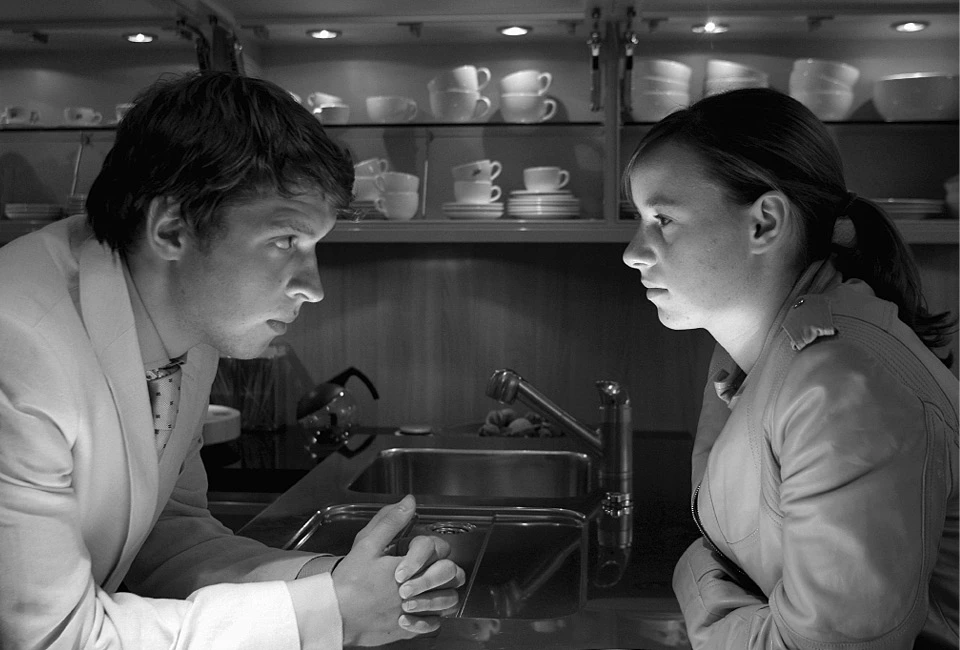
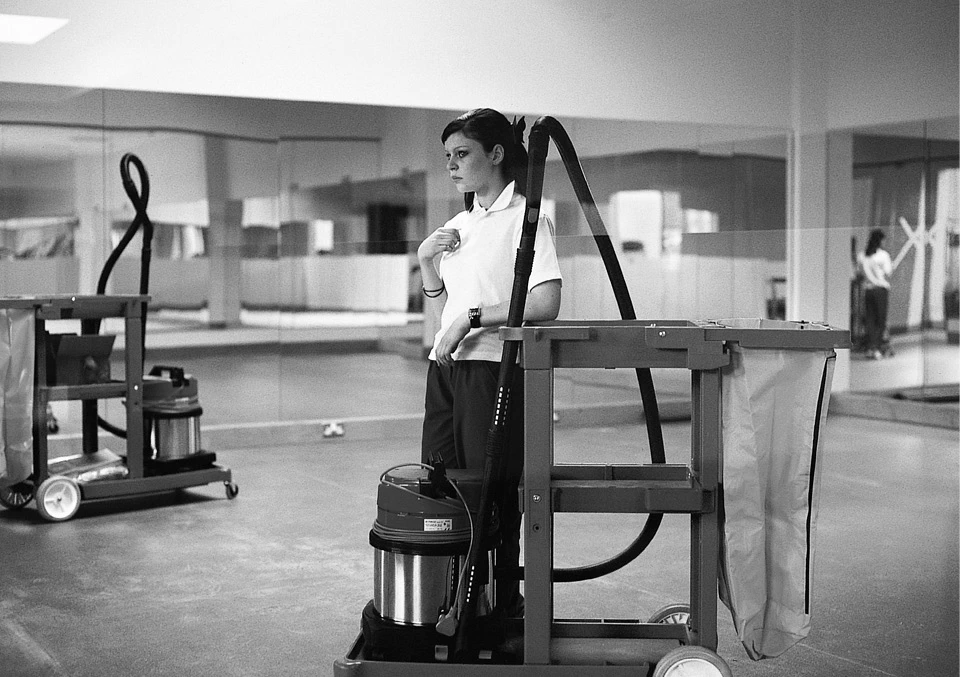
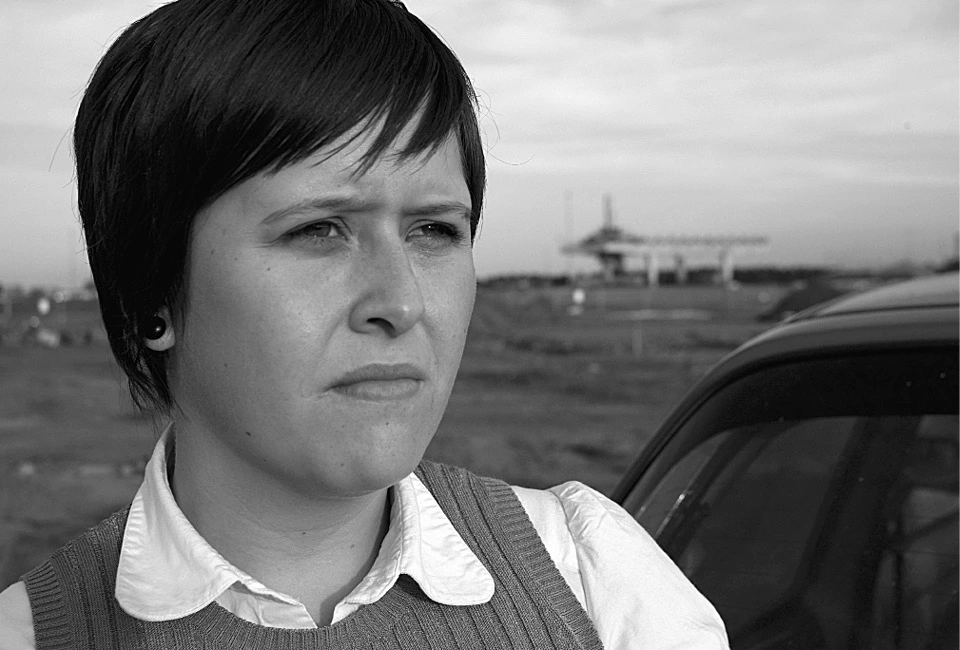
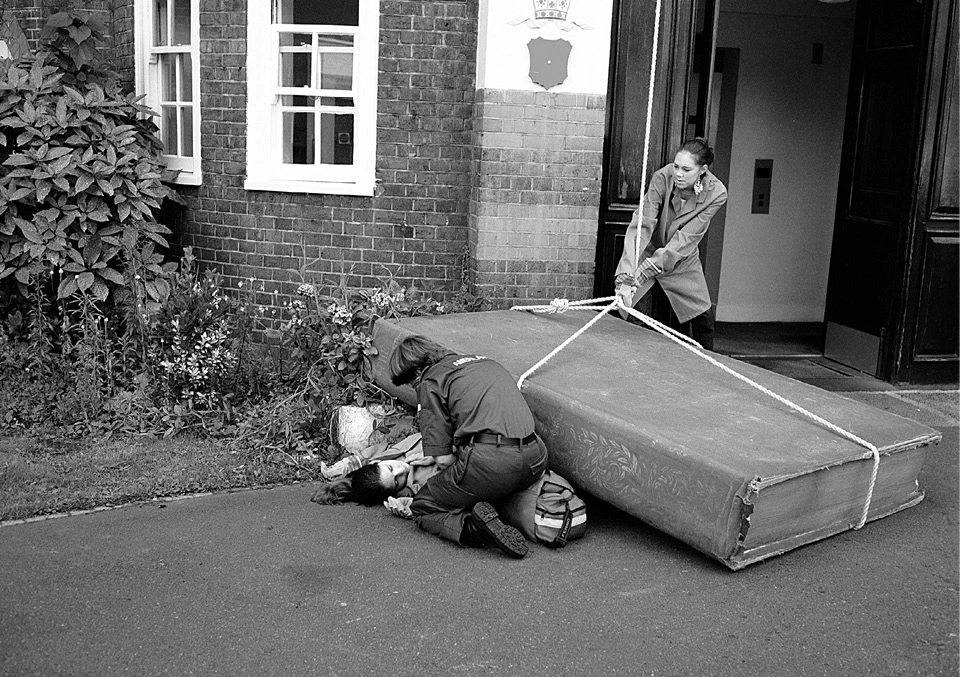
Clockwise from top left: Helen – photograph by Joe Lawlor; Leisure Centre – photograph by Susan Gogan; Revolution – photograph by Chris Dorley-Brown; Daydream – film still.
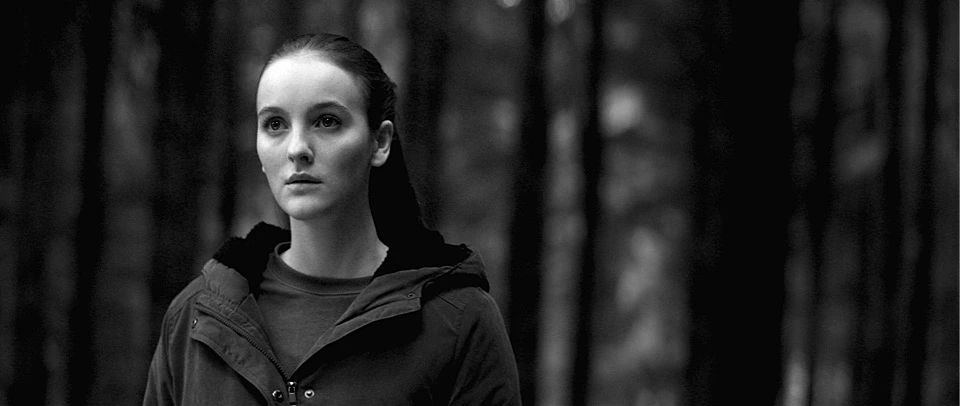
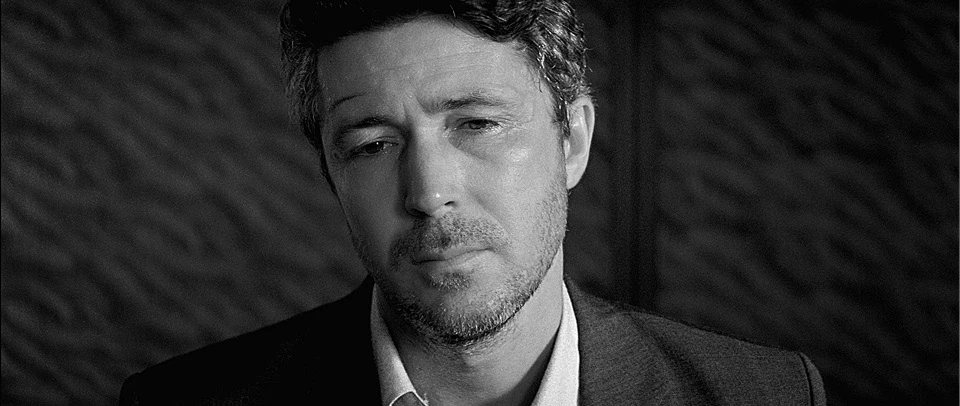
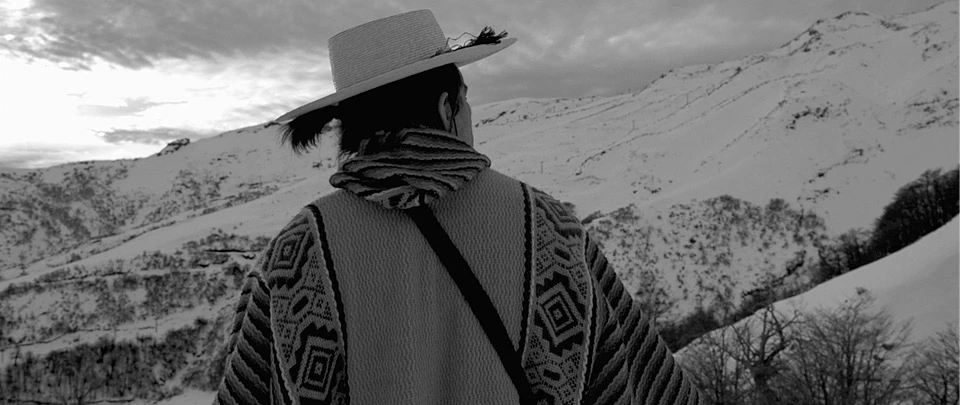
From top: Rose Plays Julie – film still; Mister John – photograph by Hugo Glendinning; Further Beyond – film still.
